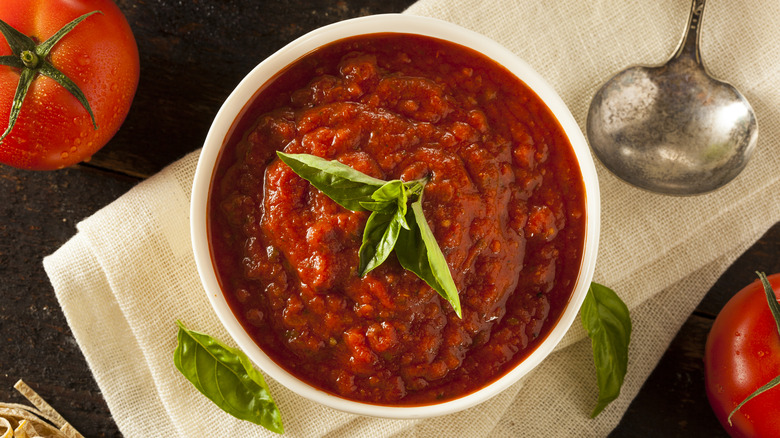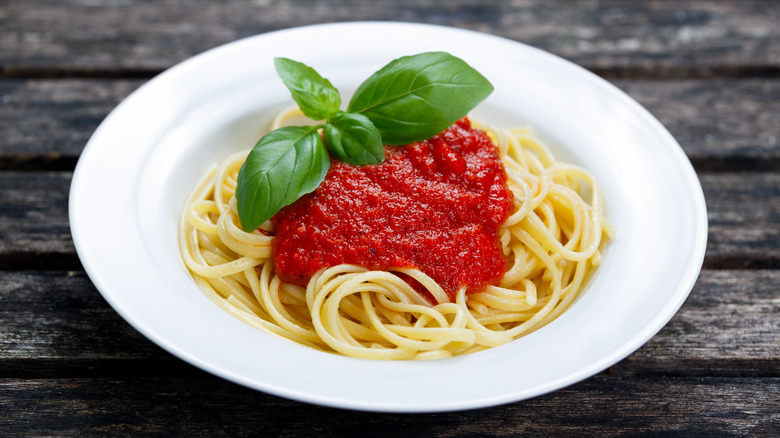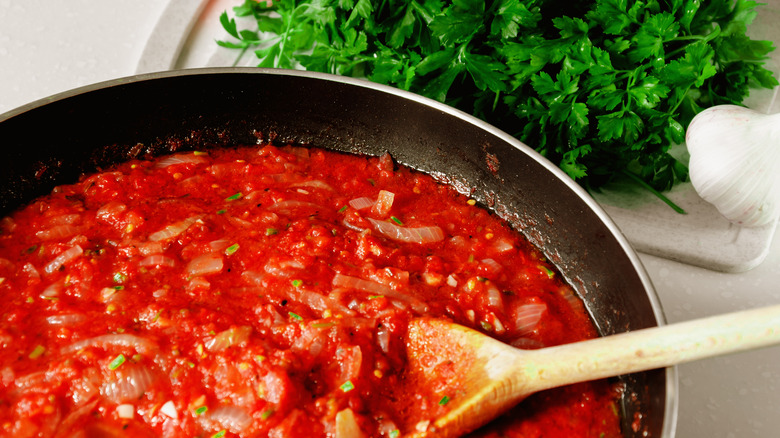Here's How Marinara Sauce May Have Gotten Its Name
Marinara sauce is such a simple classic that, at first, it feels weird to think there's any hidden significance behind its name. Stopping to consider this, though, one does have to wonder why we don't just call it tomato sauce. Well, for one thing, marinara is a type of tomato sauce, so the moniker mainly helps to specify things.
As noted by MasterClass, this thick, red, acidic tomato sauce adds ingredients like basil, garlic, olive oil, oregano, and/or red pepper to spice things up. Adding protein like beef, especially in meatball form, also helps give it a stronger identity. Pasta is the iconic vehicle for marinara's complex flavors, but items like breaded finger foods can easily be dipped in, too. Delighted Cooking mentions that marinara's easy-to-make qualities — simply combine and simmer ingredients — are a big part of what makes it so popular. Nonetheless, marinara can be a premium pasta sauce as well, with many gourmet varieties found on supermarket shelves and in restaurants.
So, where did such a versatile sauce's name come from?
The Italians named marinara sauce
Unsurprisingly, it was in Italy where marinara received its moniker. As noted by Merriam-Webster, before the Italian word "marinara" referred to a sauce, it translated to something like "sailor style." The Saturday Evening Post points out that the Italian word "marinara" comes from the Latin word "mare," meaning "sea." What does marinara have to do with the sea, though?
In the 1500s, per MasterClass, the Spanish introduced the tomato to Italy, then cooks in Naples used it to create the sauce that came to be known as "marinara." According to Delighted Cooking, this concoction apparently soon became popular among sailors, for one reason or another. It might have been that simple, acidic, and originally meatless sauce kept well aboard ships and thus caught on with seafarers. Alternatively, it could have been that the ease and swiftness involved in preparing marinara sauce made it a popular choice for the spouses of returning sailors when cooking a homecoming meal; if they saw the ship of their partner docking, they could whip up a batch of marinara sauce before the sailor got home.
How tomatoes and pasta met
There's a reason Naples was the pot in which marinara was first cooked up. Tomatoes are native to South America's Andes Mountains, near modern-day Ecuador and Peru, and they were likely domesticated in what is now Mexico, according to Encyclopedia Britannica. So, while the New World enjoyed tomatoes for quite some time, historically, it wasn't until the Columbian Exchange that the Old World got their hands on this crop. Italy was just one of the European countries to which the Spanish introduced the tomato in the 1500s. However, Italy is of course known for pasta, so it makes sense it was the nation where these two ingredients collided to help develop marinara sauce.
Surprisingly, though, Italy didn't invent pasta. The Daily Press chronicles how the earliest approximation of pasta probably dates back to ancient China, when people used millet to make noodles. However, in all likelihood, it seems to have been the Middle East that made the first sturdy, dry, cut noodles, which were eventually boiled, as well. These pastas kept well and reached Italy by the 10th century, then Italy gradually perfected the art form of pasta. Italy's dry climate and the Renaissance's mechanical innovations helped to make pasta production a breeze. Fast forward a couple of hundred years, add in the tomato, give it to pasta-eating sailors, and you've got the foundations for marinara sauce!


